Byungsoo Kim
Implicit Neural Representation for Physics-driven Actuated Soft Bodies
Jan 26, 2024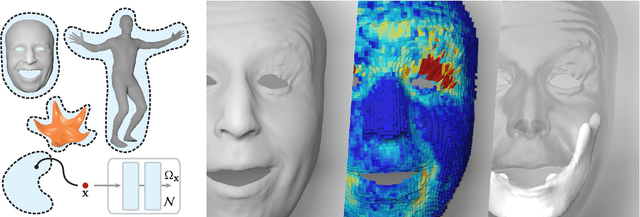


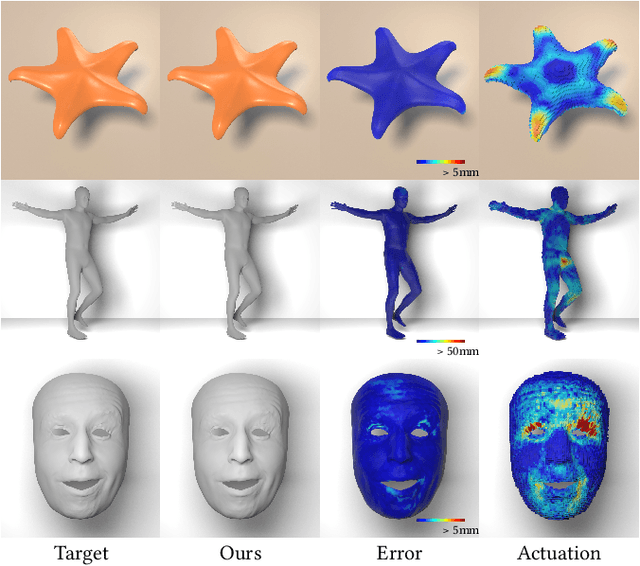
Abstract:Active soft bodies can affect their shape through an internal actuation mechanism that induces a deformation. Similar to recent work, this paper utilizes a differentiable, quasi-static, and physics-based simulation layer to optimize for actuation signals parameterized by neural networks. Our key contribution is a general and implicit formulation to control active soft bodies by defining a function that enables a continuous mapping from a spatial point in the material space to the actuation value. This property allows us to capture the signal's dominant frequencies, making the method discretization agnostic and widely applicable. We extend our implicit model to mandible kinematics for the particular case of facial animation and show that we can reliably reproduce facial expressions captured with high-quality capture systems. We apply the method to volumetric soft bodies, human poses, and facial expressions, demonstrating artist-friendly properties, such as simple control over the latent space and resolution invariance at test time.
Near-realtime Facial Animation by Deep 3D Simulation Super-Resolution
May 05, 2023Abstract:We present a neural network-based simulation super-resolution framework that can efficiently and realistically enhance a facial performance produced by a low-cost, realtime physics-based simulation to a level of detail that closely approximates that of a reference-quality off-line simulator with much higher resolution (26x element count in our examples) and accurate physical modeling. Our approach is rooted in our ability to construct - via simulation - a training set of paired frames, from the low- and high-resolution simulators respectively, that are in semantic correspondence with each other. We use face animation as an exemplar of such a simulation domain, where creating this semantic congruence is achieved by simply dialing in the same muscle actuation controls and skeletal pose in the two simulators. Our proposed neural network super-resolution framework generalizes from this training set to unseen expressions, compensates for modeling discrepancies between the two simulations due to limited resolution or cost-cutting approximations in the real-time variant, and does not require any semantic descriptors or parameters to be provided as input, other than the result of the real-time simulation. We evaluate the efficacy of our pipeline on a variety of expressive performances and provide comparisons and ablation experiments for plausible variations and alternatives to our proposed scheme.
Raw Produce Quality Detection with Shifted Window Self-Attention
Dec 24, 2021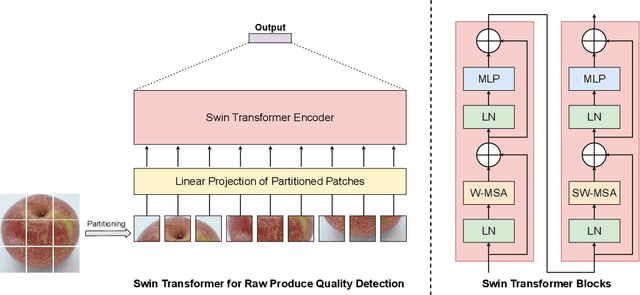
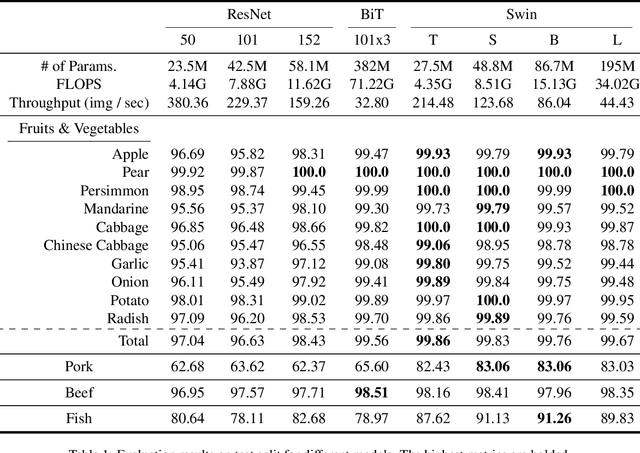
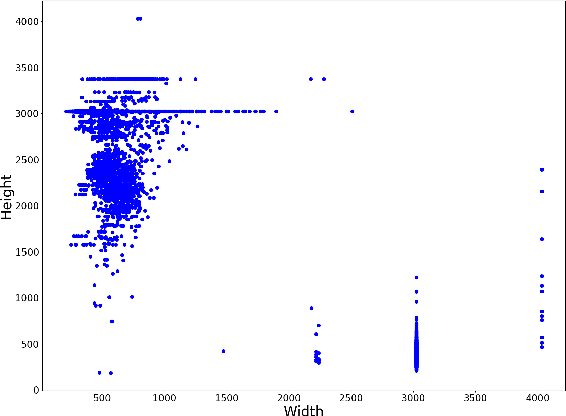
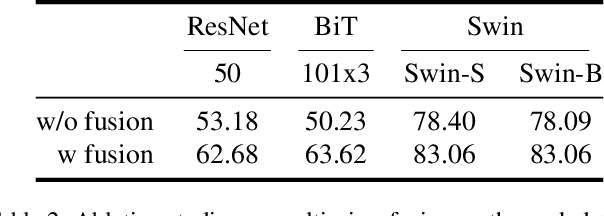
Abstract:Global food insecurity is expected to worsen in the coming decades with the accelerated rate of climate change and the rapidly increasing population. In this vein, it is important to remove inefficiencies at every level of food production. The recent advances in deep learning can help reduce such inefficiencies, yet their application has not yet become mainstream throughout the industry, inducing economic costs at a massive scale. To this point, modern techniques such as CNNs (Convolutional Neural Networks) have been applied to RPQD (Raw Produce Quality Detection) tasks. On the other hand, Transformer's successful debut in the vision among other modalities led us to expect a better performance with these Transformer-based models in RPQD. In this work, we exclusively investigate the recent state-of-the-art Swin (Shifted Windows) Transformer which computes self-attention in both intra- and inter-window fashion. We compare Swin Transformer against CNN models on four RPQD image datasets, each containing different kinds of raw produce: fruits and vegetables, fish, pork, and beef. We observe that Swin Transformer not only achieves better or competitive performance but also is data- and compute-efficient, making it ideal for actual deployment in real-world setting. To the best of our knowledge, this is the first large-scale empirical study on RPQD task, which we hope will gain more attention in future works.
Knowledge Transfer by Discriminative Pre-training for Academic Performance Prediction
Jul 12, 2021



Abstract:The needs for precisely estimating a student's academic performance have been emphasized with an increasing amount of attention paid to Intelligent Tutoring System (ITS). However, since labels for academic performance, such as test scores, are collected from outside of ITS, obtaining the labels is costly, leading to label-scarcity problem which brings challenge in taking machine learning approaches for academic performance prediction. To this end, inspired by the recent advancement of pre-training method in natural language processing community, we propose DPA, a transfer learning framework with Discriminative Pre-training tasks for Academic performance prediction. DPA pre-trains two models, a generator and a discriminator, and fine-tunes the discriminator on academic performance prediction. In DPA's pre-training phase, a sequence of interactions where some tokens are masked is provided to the generator which is trained to reconstruct the original sequence. Then, the discriminator takes an interaction sequence where the masked tokens are replaced by the generator's outputs, and is trained to predict the originalities of all tokens in the sequence. Compared to the previous state-of-the-art generative pre-training method, DPA is more sample efficient, leading to fast convergence to lower academic performance prediction error. We conduct extensive experimental studies on a real-world dataset obtained from a multi-platform ITS application and show that DPA outperforms the previous state-of-the-art generative pre-training method with a reduction of 4.05% in mean absolute error and more robust to increased label-scarcity.
Consistency and Monotonicity Regularization for Neural Knowledge Tracing
May 03, 2021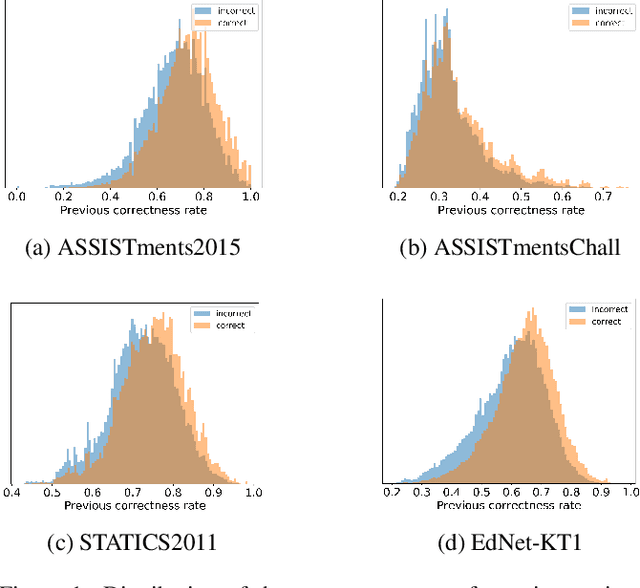
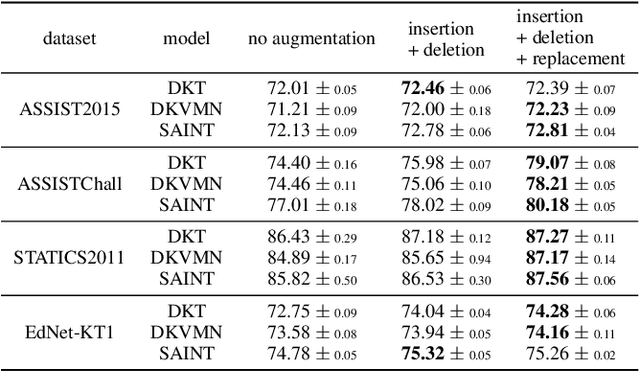


Abstract:Knowledge Tracing (KT), tracking a human's knowledge acquisition, is a central component in online learning and AI in Education. In this paper, we present a simple, yet effective strategy to improve the generalization ability of KT models: we propose three types of novel data augmentation, coined replacement, insertion, and deletion, along with corresponding regularization losses that impose certain consistency or monotonicity biases on the model's predictions for the original and augmented sequence. Extensive experiments on various KT benchmarks show that our regularization scheme consistently improves the model performances, under 3 widely-used neural networks and 4 public benchmarks, e.g., it yields 6.3% improvement in AUC under the DKT model and the ASSISTmentsChall dataset.
SAINT+: Integrating Temporal Features for EdNet Correctness Prediction
Oct 19, 2020
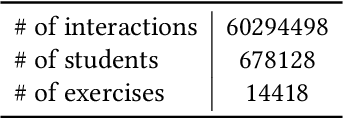
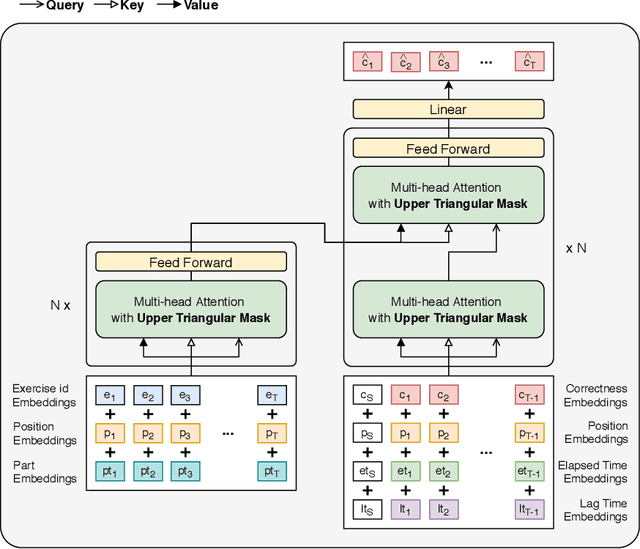
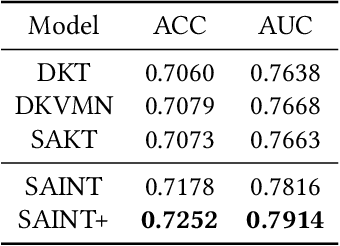
Abstract:We propose SAINT+, a successor of SAINT which is a Transformer based knowledge tracing model that separately processes exercise information and student response information. Following the architecture of SAINT, SAINT+ has an encoder-decoder structure where the encoder applies self-attention layers to a stream of exercise embeddings, and the decoder alternately applies self-attention layers and encoder-decoder attention layers to streams of response embeddings and encoder output. Moreover, SAINT+ incorporates two temporal feature embeddings into the response embeddings: elapsed time, the time taken for a student to answer, and lag time, the time interval between adjacent learning activities. We empirically evaluate the effectiveness of SAINT+ on EdNet, the largest publicly available benchmark dataset in the education domain. Experimental results show that SAINT+ achieves state-of-the-art performance in knowledge tracing with an improvement of 1.25% in area under receiver operating characteristic curve compared to SAINT, the current state-of-the-art model in EdNet dataset.
Prescribing Deep Attentive Score Prediction Attracts Improved Student Engagement
May 19, 2020



Abstract:Intelligent Tutoring Systems (ITSs) have been developed to provide students with personalized learning experiences by adaptively generating learning paths optimized for each individual. Within the vast scope of ITS, score prediction stands out as an area of study that enables students to construct individually realistic goals based on their current position. Via the expected score provided by the ITS, a student can instantaneously compare one's expected score to one's actual score, which directly corresponds to the reliability that the ITS can instill. In other words, refining the precision of predicted scores strictly correlates to the level of confidence that a student may have with an ITS, which will evidently ensue improved student engagement. However, previous studies have solely concentrated on improving the performance of a prediction model, largely lacking focus on the benefits generated by its practical application. In this paper, we demonstrate that the accuracy of the score prediction model deployed in a real-world setting significantly impacts user engagement by providing empirical evidence. To that end, we apply a state-of-the-art deep attentive neural network-based score prediction model to Santa, a multi-platform English ITS with approximately 780K users in South Korea that exclusively focuses on the TOEIC (Test of English for International Communications) standardized examinations. We run a controlled A/B test on the ITS with two models, respectively based on collaborative filtering and deep attentive neural networks, to verify whether the more accurate model engenders any student engagement. The results conclude that the attentive model not only induces high student morale (e.g. higher diagnostic test completion ratio, number of questions answered, etc.) but also encourages active engagement (e.g. higher purchase rate, improved total profit, etc.) on Santa.
Choose Your Own Question: Encouraging Self-Personalization in Learning Path Construction
May 08, 2020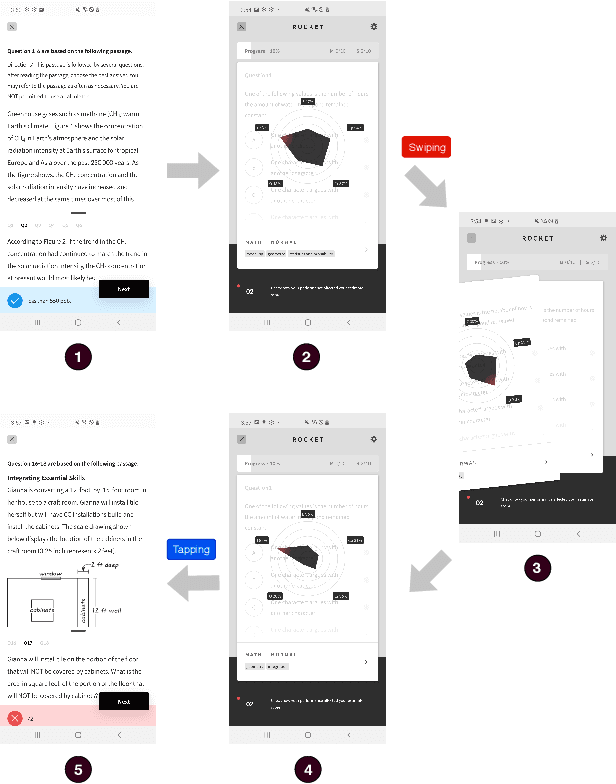
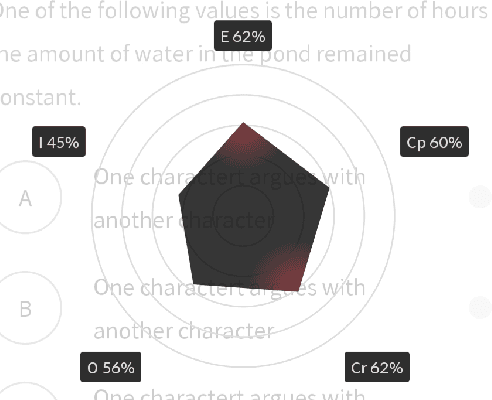
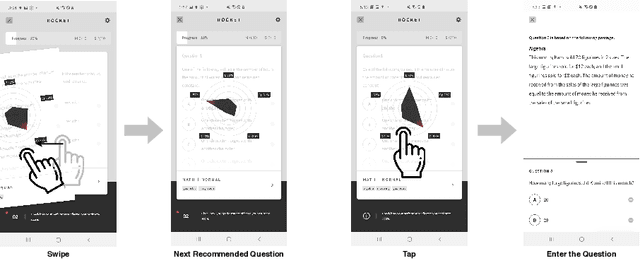

Abstract:Learning Path Recommendation is the heart of adaptive learning, the educational paradigm of an Interactive Educational System (IES) providing a personalized learning experience based on the student's history of learning activities. In typical existing IESs, the student must fully consume a recommended learning item to be provided a new recommendation. This workflow comes with several limitations. For example, there is no opportunity for the student to give feedback on the choice of learning items made by the IES. Furthermore, the mechanism by which the choice is made is opaque to the student, limiting the student's ability to track their learning. To this end, we introduce Rocket, a Tinder-like User Interface for a general class of IESs. Rocket provides a visual representation of Artificial Intelligence (AI)-extracted features of learning materials, allowing the student to quickly decide whether the material meets their needs. The student can choose between engaging with the material and receiving a new recommendation by swiping or tapping. Rocket offers the following potential improvements for IES User Interfaces: First, Rocket enhances the explainability of IES recommendations by showing students a visual summary of the meaningful AI-extracted features used in the decision-making process. Second, Rocket enables self-personalization of the learning experience by leveraging the students' knowledge of their own abilities and needs. Finally, Rocket provides students with fine-grained information on their learning path, giving them an avenue to assess their own skills and track their learning progress. We present the source code of Rocket, in which we emphasize the independence and extensibility of each component, and make it publicly available for all purposes.
Lagrangian Neural Style Transfer for Fluids
May 02, 2020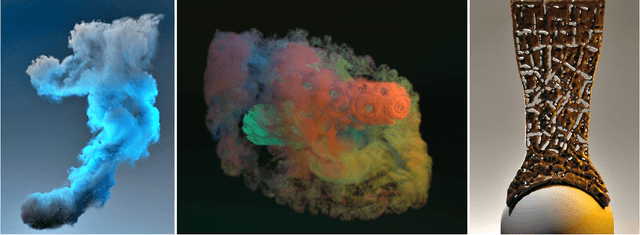

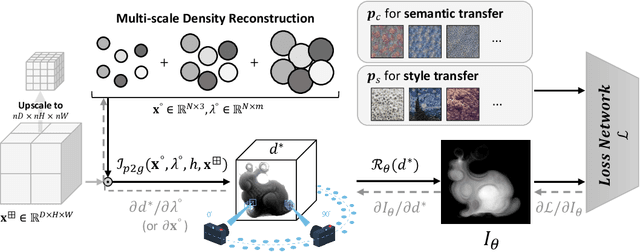
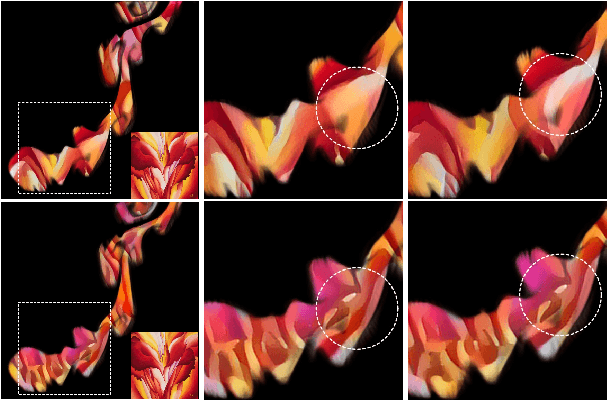
Abstract:Artistically controlling the shape, motion and appearance of fluid simulations pose major challenges in visual effects production. In this paper, we present a neural style transfer approach from images to 3D fluids formulated in a Lagrangian viewpoint. Using particles for style transfer has unique benefits compared to grid-based techniques. Attributes are stored on the particles and hence are trivially transported by the particle motion. This intrinsically ensures temporal consistency of the optimized stylized structure and notably improves the resulting quality. Simultaneously, the expensive, recursive alignment of stylization velocity fields of grid approaches is unnecessary, reducing the computation time to less than an hour and rendering neural flow stylization practical in production settings. Moreover, the Lagrangian representation improves artistic control as it allows for multi-fluid stylization and consistent color transfer from images, and the generality of the method enables stylization of smoke and liquids likewise.
* ACM Transaction on Graphics (SIGGRAPH 2020), additional materials: http://www.byungsoo.me/project/lnst/index.html
Latent Space Subdivision: Stable and Controllable Time Predictions for Fluid Flow
Mar 12, 2020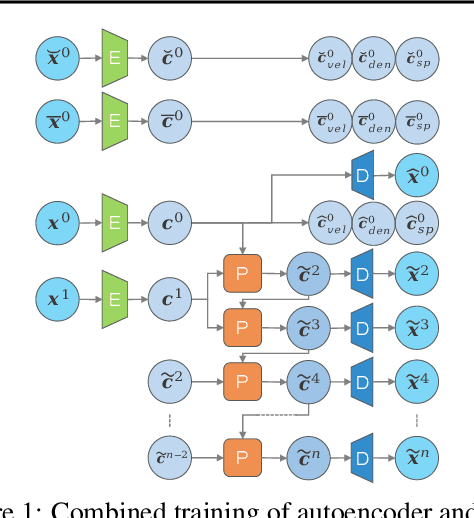
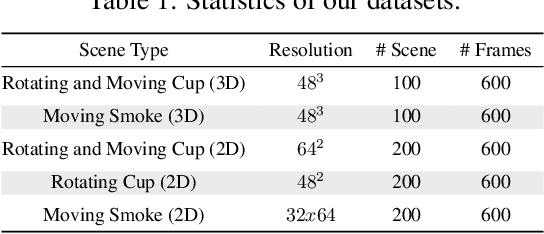

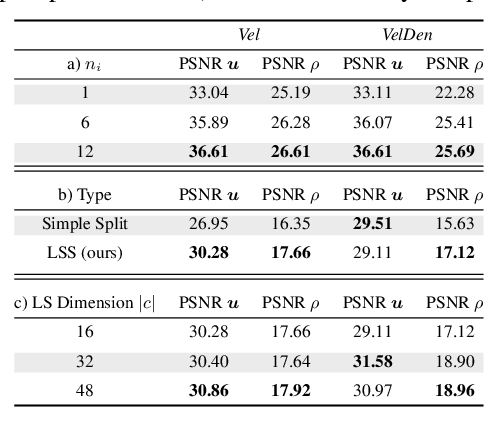
Abstract:We propose an end-to-end trained neural networkarchitecture to robustly predict the complex dynamics of fluid flows with high temporal stability. We focus on single-phase smoke simulations in 2D and 3D based on the incompressible Navier-Stokes (NS) equations, which are relevant for a wide range of practical problems. To achieve stable predictions for long-term flow sequences, a convolutional neural network (CNN) is trained for spatial compression in combination with a temporal prediction network that consists of stacked Long Short-Term Memory (LSTM) layers. Our core contribution is a novel latent space subdivision (LSS) to separate the respective input quantities into individual parts of the encoded latent space domain. This allows to distinctively alter the encoded quantities without interfering with the remaining latent space values and hence maximizes external control. By selectively overwriting parts of the predicted latent space points, our proposed method is capable to robustly predict long-term sequences of complex physics problems. In addition, we highlight the benefits of a recurrent training on the latent space creation, which is performed by the spatial compression network.
 Add to Chrome
Add to Chrome Add to Firefox
Add to Firefox Add to Edge
Add to Edge